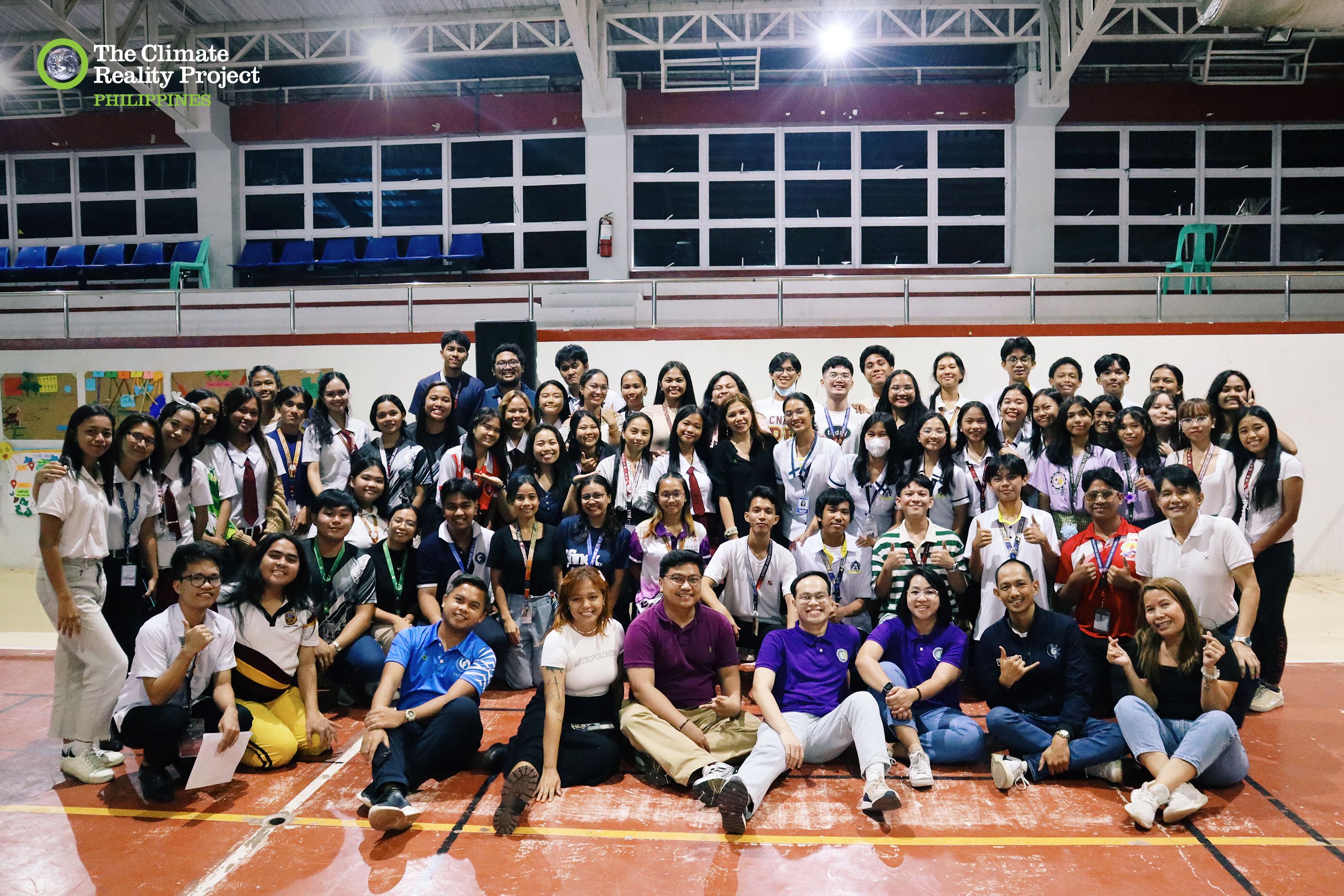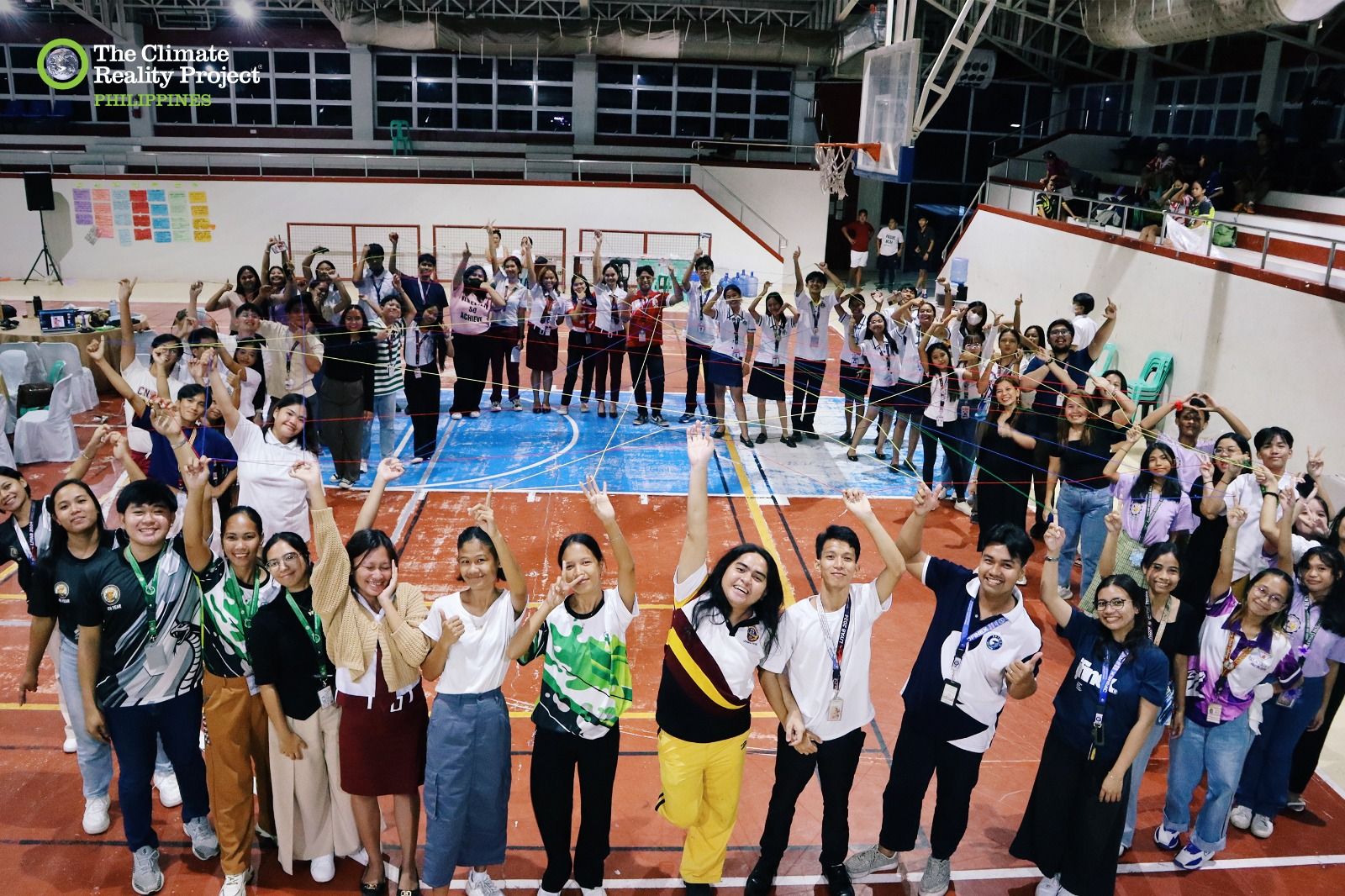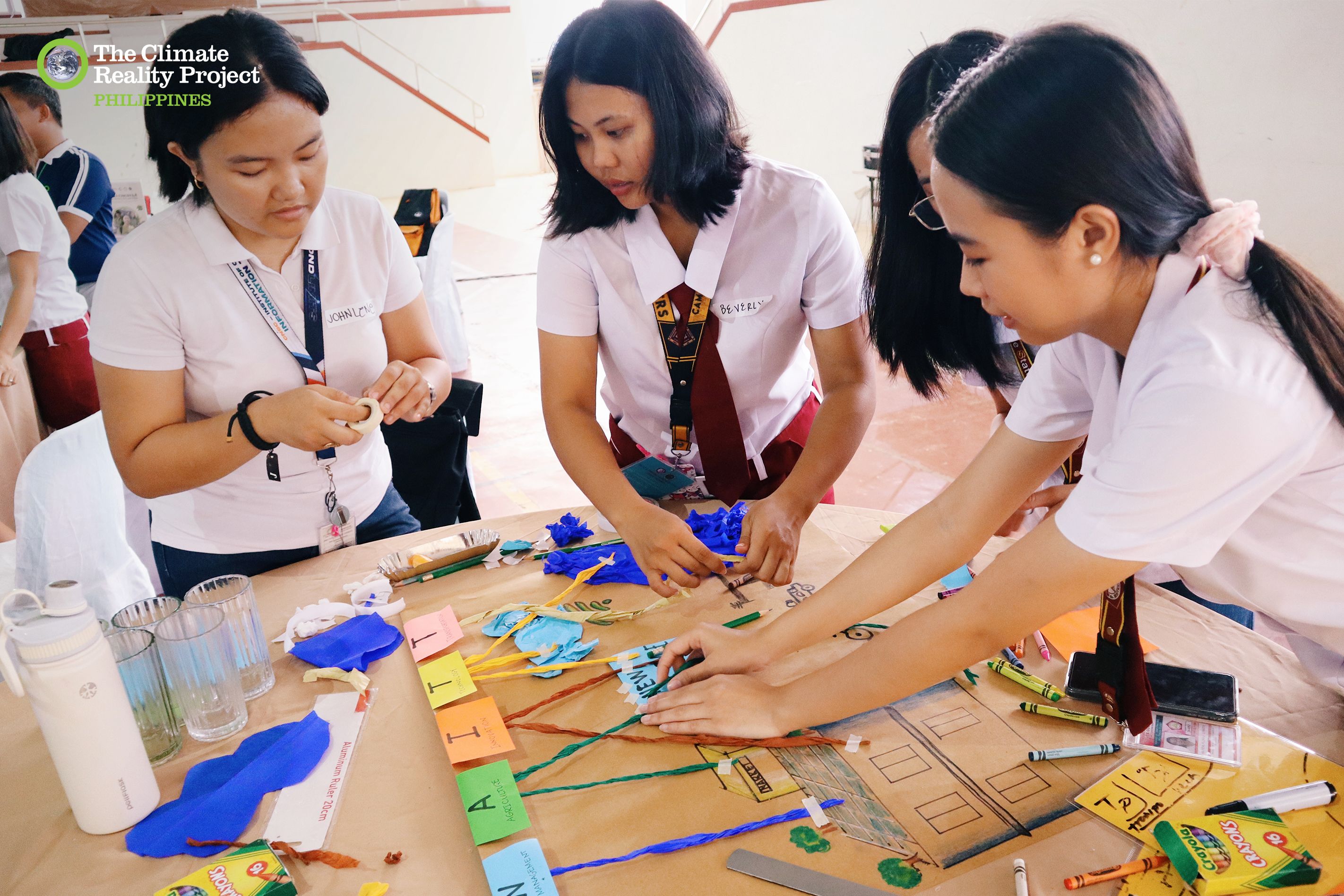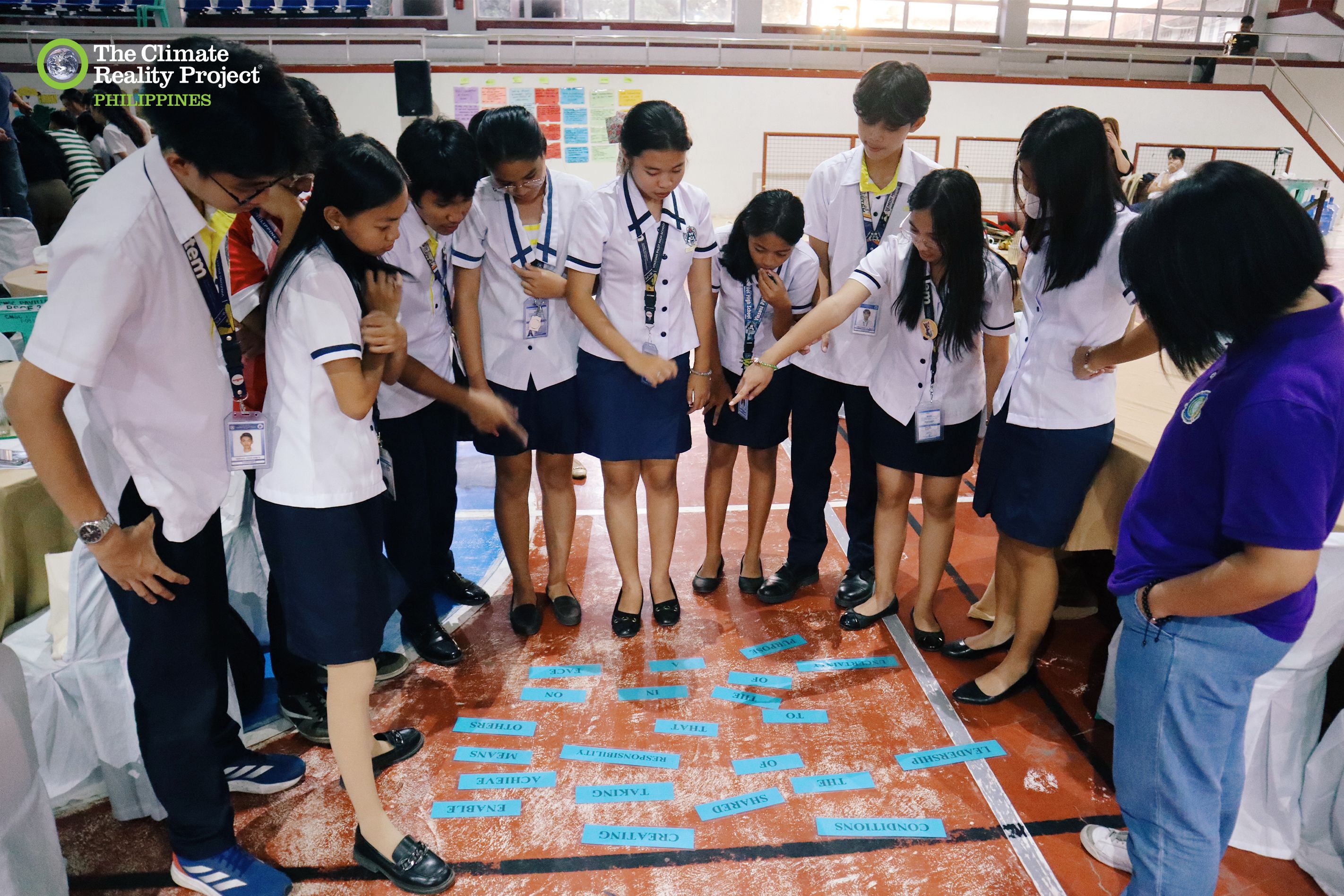Student leaders in Camarines Norte pledge to push for a plastic-free planet
Hosting its biggest group of students yet, Klima Eskwela capped off a successful 2024 run with a visit to the Camarines Norte State College (CNSC).
Klima Eskwela aims to make advocates out of the youth. Its lectures were designed to leverage students’ experience with global warming and, in turn, stir them into action.
More than 80 student leaders from CNSC and neighboring schools joined the two-day event, where they were taught to craft campaigns against plastic dependence. Senior high school students were also among the attendees.
This Klima Eskwela leg was made possible by The Climate Reality Project Philippines’ partnership with the Climate Change Commission (CCC) and CNSC’s Union of Supreme Student Government (USSG).
Speakers included CCC Development Management Officer Jean Kyle Wernher Dela Cruz, Climate Reality Leaders Joey Totanes of the Provincial Disaster Risk Reduction and Management Office and Vincer Quibral of Glorious Land Ecofarm, and teacher Sarah Kimberly Cacho from the Vinzons Pilot High School.
Also in attendance were Matt Jenno Balce from the Department of Environment and Natural Resources - Camarines Norte and Engr. Victor Zabala, head of the Labo Municipal Environment and Natural Resources Office.

Fertile ground for climate anxiety
CNSC sits beside a busy highway in the provincial capital. On a normal school day, its red-roofed buildings are abuzz with chatter. With students rushing to class or relaxing under the shade of trees, laughter is never out of earshot.
Not all days at CNSC are normal, however. There are times when campus grounds are empty, silenced by class suspensions due to extreme weather events.
Located right beside the Pacific Ocean, Bicol Region (of which Camarines Norte is part) is especially prone to typhoons. Camarines Norte is also vulnerable to high temperatures, reaching a heat index of 42 degrees Celsius last summer.
“‘Yung papa ko po is a rice farmer. ‘Yung sakahan namin ay tuyong-tuyo na, tapos wala pang water source dahil sa bundok siya. [...] Minsan lang, ang ginagawa niya ‘di na siya nagtatanim ‘pag ganitong sobrang init. Kasi sa sobrang init, wala kaming makukuhanan ng tubig na malapit, kaya naghihintay na lang siya ng tag-ulan. Kaya naapektuhan kami kasi ‘yun lang ang source ng income ng papa ko. Ang hirap,” said Danica Yet, a student from CNSC’s Labo Campus.
(My father is a rice farmer. Our rice field is so dry, and because it’s up in the mountains, we don’t have a water source for it. Sometimes, when it gets this hot, my father no longer plants rice because there is no water source. So he waits for the rain. It affects us because that’s my father’s only source of income. It’s difficult.)
Hence, when Climate Reality Philippines’ Klima Eskwela came to CNSC, the students in attendance needed no introduction to global warming. Their familiarity with climate change has impacted more than their home and school life—it has also marred their plans for the future.

“Matagal na po kasi akong concerned sa climate change, and it has been impacting my mindset recently kasi minsan napapaisip ako if worth it pang magpatuloy mag-aral. [...] Minsan nade-depress ako kasi paano ‘pag nag-graduate ako tapos biglang [nagkaroon ng calamity] tapos nawala ‘yung pinaghirapan ko,” shared Ivan Lamadrid, a student from CNSC.
(I’ve been concerned with climate change for a long time, and it has been impacting my mindset recently because I keep thinking if studying is still worth it. [...] Sometimes I get depressed because what if after I graduate, a calamity comes and renders my hard work useless?”)
The students were given a sensory mapping task to help stem these anxious thoughts. Using various art materials, participants created astounding illustrations of what a bright future looks like to them. Their works incorporated concepts of renewable energy, disaster resilience, and sustainable community development.
Sowing the seeds of a plastic-free reality
A huge chunk of Klima Eskwela’s sessions also shed light on a crucial aspect of global warming: the plastic crisis. The discussion on plastics was led by Aimee Oliveros, the head and deputy branch manager of Climate Reality Philippines’ Plastic-Free Reality Program.
“We want to focus Klima Eskwela on plastics because we see that it’s very apparent [in our communities]. And you, the youth, have the power to look for solutions and be part of the solution,” said Oliveros.
The Plastic-Free Reality Program, Klima Eskwela’s mother project, aims to raise awareness on how the plastic industry is a leading driver of climate change. Commonly attributed to pollution, plastics actually contribute to making our planet hotter in every stage of its life cycle.
Pollution is incidentally another issue close to the participants’ hearts, with their school so close to a huge landfill teeming with plastic waste. Combine that with their experience with global warming, it was not difficult to convince them of the link between plastics and climate change.
Anecdotes and questions poured from the crowd following the eye-opening lectures, especially after CCC’s discussion on eco-friendly solutions to the plastic crisis.
The enthusiasm from the students was channeled right into a series of campaigning workshops, led by AktivAsia Philippines. These sessions taught students how to prioritize a plastic issue in their school and formulate plans to address it.

Young as they were, the students proved to be very perceptive on how their schools should eliminate plastic usage. With guidance from CCC and AktivAsia, they succeeded in crafting draft campaigns. Most of their ideas focused on revising existing policies to reflect stricter measures on plastic consumption and waste management.
Climate action taking root
Among the crowd were leaders from the USSG, whose efforts brought Klima Eskwela to their school. The USSG officers are also actively working toward making their campus greener by proposing a revamp of their school’s environment policy.
“The environmental policy [na pino-propose namin], malawak siya eh. We’re urging CNSC as a community to declare climate action. And in declaring so, pinakauna naming priority dito ay magkaroon ng green procurement policy ang CNSC, by this itutulak talaga niya ‘yung projects and procurements [that are good for the environment]. Part nito ‘yung solarization [ng energy sources] and ‘yung hindi na paggamit ng plastics [sa campus],” said USSG Chair Adonis “Undo” Salen II.
(The environmental policy [that we’re proposing] is expansive. We’re urging CNSC as a community to declare climate action. And in declaring so, our first priority here is for CNSC to have a green procurement policy, and by this, it will push for projects that are good for the environment. These include the [solarization of energy resources] and eliminating the use of plastics [in the campus].)

The USSG is optimistic that even after Klima Eskwela, the students will continue learning new ways to campaign against plastics. Taking pride in the event’s success, Salen shared how eager the participants were to share their learnings with their classmates.
“Naniniwala kami na hindi lang learnings o knowledge ang dala sa amin ng [Klima Eskwela] kundi ang pag-asa rin na hindi ‘yung mga problema o climate impacts ang end. Mayroon pang espasyo para gumalaw tayo. [...] I think this is a step to igniting the passion of the youth in climate action,” said Salen.
(We believe that Klima Eskwela brings to us not only knowledge but also hope that the adverse effects of climate change are not the end. We have the space to take action.)
This was ultimately showcased in Klima Eskwela’s last activity, wherein the students were asked what kind of leaders they wanted to be. Many pledged to be an inspiration to their fellow youth, while a number wanted to start advocating at home.
After each answer, the students passed a ball of yarn around to form a huge web, linking one to the others. From this connection, the organizers hope there springs a lifelong commitment to climate action.